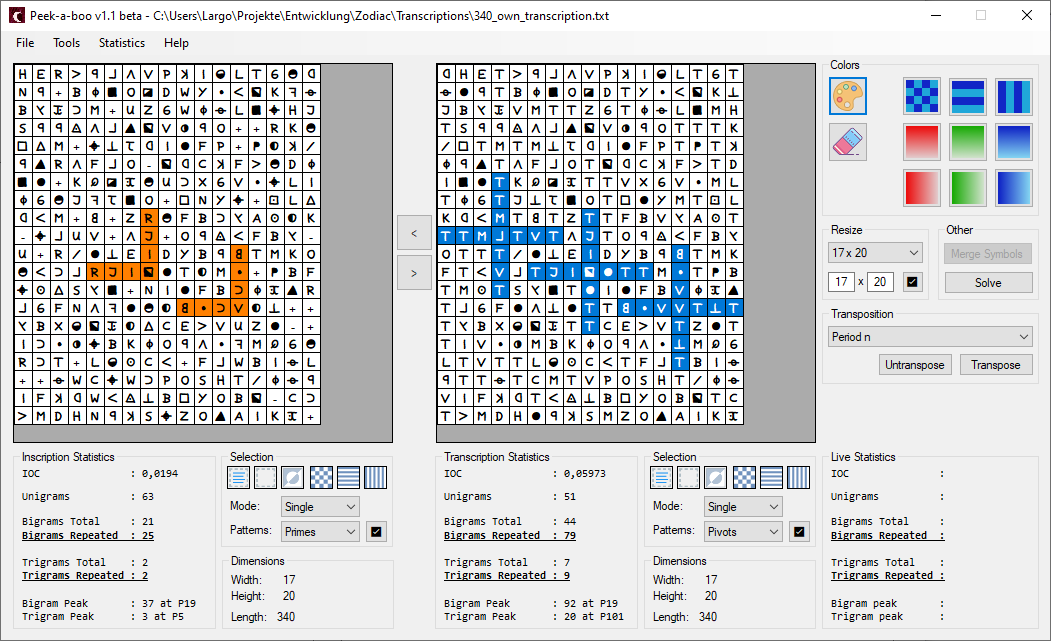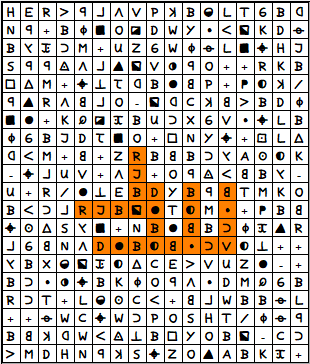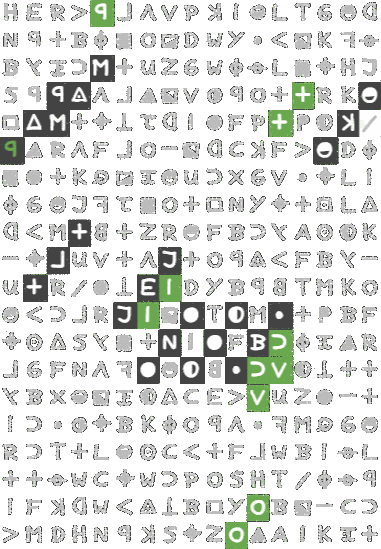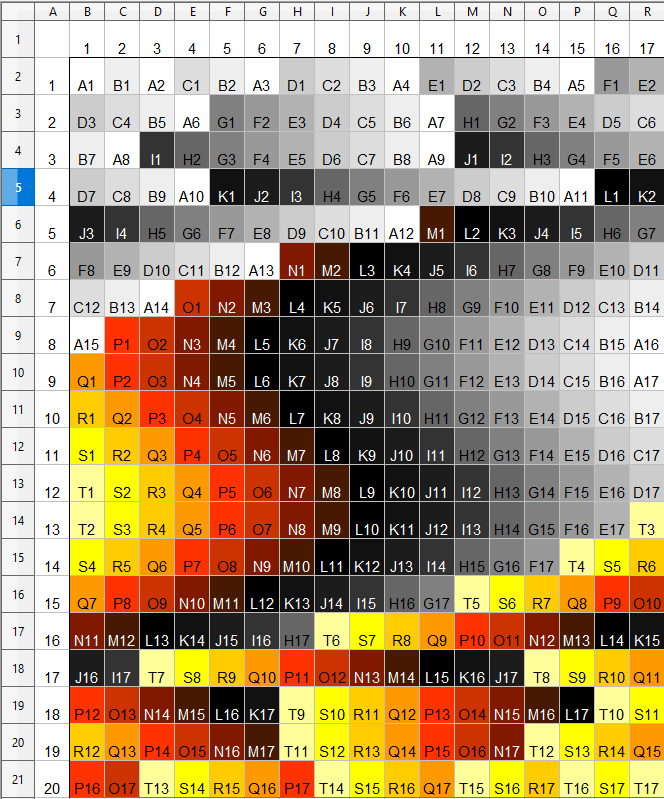Talking of crosswords
The prevalence of the ‘+’ has had me wondering if it was possibly a blacked out square in a crossword. Never made much progress with this idea, though, and it doesn’t seem to fit classical patterns of crosswords.
Why should it be, one symbol must be the most frequent one..
QT
*ZODIACHRONOLOGY*
My approach to automating would be to build a hillclimber for it. It would have some way to merge symbols from candidate incomplete pivots to form complete ones. Then it would count the total number of complete, intact pivots, and try to maximize the count.
But maybe a brute force search is possible, since there is a limited number of candidate incomplete pivots. Then you could pick the set of merges that produced the largest count of completed pivots. If that’s possible, then the count would be a good way to measure how "susceptible" Z340 is to these partial pivots, vs shuffled ciphers or other test ciphers. It also leads to the question: Should the search include pivots in different orientations?
I’d enjoy working on such an algorithm but I doubt I’ll ever get time in the near future.
I am getting interested in the 340 again lately and will consider doing something similar in upcoming weeks or months. I might be able to do this with a spreadsheet. One iteration = 1 row, and one of my computers can easily handle 10,000 maybe 20,000 iterations. In each row I would just have a key, then substitutions ( letters ), then for each position ask if the position 16, 32 or 48 ahead or behind is the same letter. If so, that position would be true. If the number of true positions is higher, then keep the key, otherwise use the prior key. I like the idea of comparing test messages with actual pivots in them and shuffled messages. This is on my to do list.
I’m not so sure anymore how meaningful pivots are that are created by merging symbols. Here is a small example. z340 was shifted to the right by one and then a few symbols were merged. This was the result:
As you can see, patterns can be created very easily without destroying existing pivots. I’m not sure whether the mere number of complete or partial pivots is sufficient as the only scoring criterion. Even the peaks at P19 and P101 remain (which is no wonder, it seems normal to me).
However, I do not want to question the pivot search approach. Especially since it looks like a pattern in the area of the two existing pivots that is worth investigating.
Yes I was thinking about that, Largo. I could probably make a route cryptogram at P20, then try to merge symbols to increase P20, but it wouldn’t give me the key. I still might try though. I think that a pattern made out of letters is a very plausible explanation for how all of the patterns and statistics relate to each other, and it would have been very easy to do.
I think that a pattern made out of letters is a very plausible explanation for how all of the patterns and statistics relate to each other, and it would have been very easy to do.
Probably the following was already discovered and discussed at some point (as almost always). Nevertheless, I would like to briefly show a small discovery, which could be connected with such a pattern. If it is already known, just ignore this post.
If you search for doublets instead of ngrams (symbols that repeat themselves directly), then z340 has a peak of 18 doublets on P78. I know that this plays a role in the Kasiski examination. But since I’ve never been into that in detail, I’m not sure if it’s the same discovery.
In a test of 10,000,000 shuffels, only 1185 ciphers had 18 or more doublets. That seems significant to me.
Sorry if I only repeat what is already known.
Translated with http://www.DeepL.com/Translator
If you search for doublets instead of ngrams (symbols that repeat themselves directly), then z340 has a peak of 18 doublets on P78. I know that this plays a role in the Kasiski examination. But since I’ve never been into that in detail, I’m not sure if it’s the same discovery.
In a test of 10,000,000 shuffels, only 1185 ciphers had 18 or more doublets. That seems significant to me.
Yes, it is the same. The 408 at period 4 transposed or period 102 untransposed has an even more significant doublet peak.
Probably the following was already discovered and discussed at some point (as almost always). Nevertheless, I would like to briefly show a small discovery, which could be connected with such a pattern. If it is already known, just ignore this post.
If you search for doublets instead of ngrams (symbols that repeat themselves directly), then z340 has a peak of 18 doublets on P78. I know that this plays a role in the Kasiski examination. But since I’ve never been into that in detail, I’m not sure if it’s the same discovery.
In a test of 10,000,000 shuffels, only 1185 ciphers had 18 or more doublets. That seems significant to me.Sorry if I only repeat what is already known.
It has been noted before but don’t be sorry for it! Confirmation of observations is always good.
http://zodiackillerciphers.com/wiki/ind … mination_2
It’s interesting that P78 is twice the period of the pivots.
78 is also 3 alphabets long (78 = 26 x 3).
Largo ~
I believe that a lot of these observations are related somehow. Read through this thread.
There are period 26 bigram repeats on period 78, and period 39 bigram repeats on period 78. All multiples of 13.
Cool idea! Do you happen to have a text version?
Sure:
................. ........X........ ........X........ ......XXXXX...... ....XX..X..XX.... ...X....X....X... ...X....X....X... ..X.....X.....X.. XXXXXXXXXXXXXXXXX ..X.....X.....X.. ...X....X....X... ...X....X....X... ....XX..X..XX.... ......XXXXX...... ........X........ ........X........ ........X........ ................. ................. .................If you squeezed two small crosshairs symbols in there, the axes of each one would contribute to pivots.
Thanks. If you encode it the cipher ends up with like 160+ bigrams at least:
JY.C8W#X0T!X0TCY. C8W#X0]^&?[3GV^/[ 3/[P+J_EI'QY.C8T! ](M:/Y.C$>K]H">KN 9(E'QY2%6AU.C^:/+ J_E'=;QY4]H,2P+J_ E_E%'QY.6J_?QDY.C 8T!1]H">L.C8W,#X0 >KN9(MYB.]H">@KY RR5F,B@4,B@R-5F .:S[3GV^Z&?P+J7_E 'QY*.CM:</[3GOVJ_ E'Q)Y.C8DW#X01T!] H">KLIN9$(M2%:/[3 GV/C8W;4,B#X0T!] H">KNV^9@!]H">KN9 (M0T!]W#BX0T!!]H" >KN9(M:/@[3GV^>KN /[30V^&_K:/[3GV^& ?P+J_E'QY.C8?P+J_ 1 2 3 4 5 6 7 8 9 10 11 8 9 10 4 2 3 4 5 6 7 8 9 12 13 14 15 16 17 18 19 13 20 16 17 20 16 21 22 1 23 24 25 26 27 2 3 4 5 10 11 12 28 29 30 20 2 3 4 31 32 33 12 34 35 32 33 36 37 28 24 26 27 2 38 39 40 41 42 3 4 13 30 20 22 1 23 24 26 43 44 27 2 45 12 34 46 38 21 22 1 23 24 23 24 39 26 27 2 3 40 1 23 15 27 47 2 3 4 5 10 11 48 12 34 35 32 49 3 4 5 6 46 7 8 9 32 33 50 36 37 28 29 2 51 3 12 34 35 32 52 33 2 53 53 54 55 46 50 51 52 45 46 50 51 52 53 56 54 55 3 30 57 16 17 18 19 13 58 14 15 21 22 1 59 23 24 26 27 2 60 3 4 29 30 61 20 16 17 18 62 19 1 23 24 26 27 63 2 3 4 5 47 6 7 8 9 48 10 11 12 34 35 32 33 49 25 36 37 31 28 29 38 39 30 20 16 17 18 19 20 4 5 6 44 45 46 50 51 7 8 9 10 11 12 34 35 32 33 36 19 13 37 52 11 12 34 35 32 33 36 37 28 29 9 10 11 12 6 7 51 8 9 10 11 11 12 34 35 32 33 36 37 28 29 30 20 52 16 17 18 19 13 32 33 36 20 16 17 9 19 13 14 23 33 30 20 16 17 18 19 13 14 15 21 22 1 23 24 26 27 2 3 4 5 15 21 22 1 23
Yes, it is the same. The 408 at period 4 transposed or period 102 untransposed has an even more significant doublet peak.
So the doublet-peak is more of a coincidence? Or does it represent any feature of the plaintext? 1185 of 10,000,000 seems to me to be quite meaningful. Do you have any idea where the doublet-peak at z408 comes from? Is it the repeated phrases ("kill", "will", "thrill" etc.)?
I believe that a lot of these observations are related somehow. Read through this thread.
viewtopic.php?f=81&t=3070
There are period 26 bigram repeats on period 78, and period 39 bigram repeats on period 78. All multiples of 13.
Thanks, I’ll read the thread. Sounds exciting!
Yes, it is the same. The 408 at period 4 transposed or period 102 untransposed has an even more significant doublet peak.
So the doublet-peak is more of a coincidence? Or does it represent any feature of the plaintext? 1185 of 10,000,000 seems to me to be quite meaningful. Do you have any idea where the doublet-peak at z408 comes from? Is it the repeated phrases ("kill", "will", "thrill" etc.)?
The doublet peak in the 340 could very well be a coincidence since the 408 also has one that is even more significant. Language plain text usually have less doublets than average (versus randomizations). The doublet peak in the 408 is also present in the plain text. The following map has the period 102 doublets in lower case but I forgot one doublet somewhere. It seems to follow the frequency distribution, no apparent bias towards "kill, thrill, will, etc", only "eBecause" seems to stand out to me, column 6 heavily involved. I just realized that period 102 is a multiple of 17 so these doublets are basically plain text repeats that line up in columns. Interesting. In the 340 this multiple is 13.
IlIKEKiLLINGPEOPl eBecauseITISSOMUC HFUNItiAmoREFUNTH ANKIllINGWILDGAME INTHEFORRESTBECAU SEMANiStHEMOATDAN GERTUEANAMALOFALl TOKILLsOMETHINGGi VESMEtHEmoATTHRIL LINGEXPEREnCEITIS eVENBeTTERTHANGET TINGYOURROCKsOFFW ITHAgiRLTHEBESTPA RTcFITIATHAEWHENi DIEIWiLLBEREBORNI NPARADICEAnDALlTH eIHAVeKILLeDWiLLB ECoMEMYSLAVEsIWIL lNOTgiVEYOUMYNAMe BecauseYOUWILLTRY TOSLOiDOWNORATOPM YCOllECTINGOFSlAV eSFORMYAFTeRLiFEE BEoRiEtEMETHHPITI
I hope you can see what’s meant. It is important to merge only P16 with P16, P32 with P32 and P48 with P48. Of course there are a lot of possibilities to merge symbols and to create incomplete pivots. A good clue are collisions when merging. If you create a new pivot and destroy an existing one, then one of the two presumed pivots is not a pivot.
Does anyone have an idea how to automate something like this? Is it worthwhile to start a test here at all?As a counter test, I created some ciphers with two pivots pointing in the same direction with my Cipher Factory. Then I marked the doublets again. Although there were some similar patterns as shown above, none of the experiments had so many possible incomplete pivots right next to the actual pivots.
Maybe we’re really dealing with a pattern?
PS: November marks the fiftieth anniversary of the release of z340. If Zodiac is still alive and enjoying it, it would be great to spoil this anniversary by solving z340.
Translated with http://www.DeepL.com/Translator
I don’t know that the significance of these patterns is as straightforward as it seems, but it might still be significant. Dan Olson pointed out that there is greater randomness in the rows than the columns of z340 and that makes complete sense if you count the number of repeating symbols in a row, divide by 17, then the number of repeating symbols by column and divide by 20 to get the averages. He does seem to think that, if a transposition was done, it was done horizontally.
Now, I don’t know if anyone has tried any of the transposition methods on paper, but I’ve been toying around with graph paper and it’s really hard to keep track of certain types of transpositions, particularly when you have to count spaces, make sure you don’t accidentally skip a line, etc.
Before I get to my main point, let me explain that I was trying to look for symmetries along the diagonal axis of the cipher, and it was just really hard to do the way it is so I retranscribed the cipher like this:
and saw this: (NOTE: I’m calling this transcription DALR for short hand)
…yeah, more pivots, but only the horizontal symmetries are obvious when you look at the original cipher, so I wanted to see what the vertical ones looked like. But, in order to do that, I had to reverse engineer the layout of the original cipher relative to this "DALR" and it was really hard to do and ended up looking like this:
But sure enough you can see that these vertical symmetries disappear when you map them back to z340
(I’m going to have to continue this in another reply)
{ CON’T }
Okay, cool. But how could this possibly mean anything? I mean, look how hard it was to get back from DALR that’s way harder than a periodic transposition. (I did apply it to z340 and I have that transcription available if anyone wants it, but I think it’s nothing)
But one thing stood out to me about the recovery map I built and that is that, for each row of cipher text, the period increases by symbol count (e.g. A.A2..A3…A4….A5) but once you get to a certain point, you get this weird sinusoidal behavior with asymptotes. So I decided to visualize that in a spreadsheet and here it is:
…and what’s interesting is that not only do the asymptotes converge under row 3 and over row 17, if you look at the middle you can see that there are 4 full lines where the relative vertical configuration of the ciphertext is maintained. (That’s rows 9 to 12)
Now I’m not convinced this means anything because I’m looking at typewriters right now, but it’s interesting because such a simple transposition on paper can yield this bizarre behavior, but if there are patterns in the original cipher then they would still be visible in the new cipher you created.
I’m setting this aside for now though because, again, I’m looking at typewriters.
EDIT: One more thing, the first time I did the transposition into DALR, I did it on graph paper. It’s easy at first but eventually the diagonal lines get really long and it gets easy to lose track of where you are. I even made a mistake when I got to the longest diagonal line in the cipher. Then I checked and, yeah, that’s exactly the line where the author made the mistake with the "K"
EDIT 2: I’m not advocating this as proof of anything, to be clear, it’s just interesting. Part of why I’m interested in reconstructing the actual physical sequence behind the 408 from plaintext to encryption to envelope is to figure out what these things might have looked like at various stages before they got turned into the ciphers we know and hate today.
But, in order to do that, I had to reverse engineer the layout of the original cipher relative to this "DALR" and it was really hard to do and ended up looking like this:
For that you can use Largo’s Peek-a-boo software: viewtopic.php?f=81&t=3255
Still need to digest the information you’ve posted though. Give me a while.







